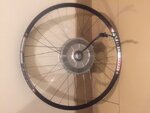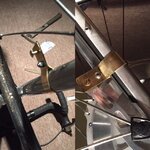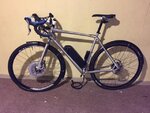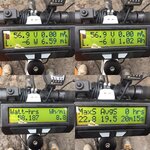JRA
Well-Known Member
I was in Vancouver today to visit my son and pick up this: (Link Removed - No Longer Exists)

I have been following Grins development of the through axle motor and it is the result of their thought process due to extensive testing of all motors and represents the solutions that they have come up with in one neat package which they explain in the link.
I know that front hub motors are not that popular but I am enjoying great success with the one I put together at the end of August. I have put about 800 miles on it averaging 25 miles per trip or so on just about every surface and dry/wet weather condition you can imagine on a drop handlebar bike with 45c tires. Basically it is a 1000w system, legal in the OR where I live, with a 48v Dolphin battery I sourced from EM3ev. The 9c motor, controller, CAv3 and thumb throttle I got from Grin.


The problem with any hub motor in the front or the rear is the torque it produces makes it want to climb out of the dropouts and so a torque arm is necessary (you can see the one on this bike in the lower left pic below the dropout). Even with a carbon fiber fork I have not had any issues with rotational forces causing any problems, even maxing out the watts climbing very steep terrain which puts the most stress on it. The solid axle like the one on this bike, which are a PITA to deal with because they mostly are 10mm and most bikes these days have 9mm drop outs. My solution was to file the flats on the axles instead of the dropouts on the ones I have done but it is fussy work. Then the disc brake mount surface is not in the right relation to the caliper so more filing.....Not the road to popularity when most are more apt to just walk in to a store and out with a complete working bike. Even though they might not understand how it works .
.
Thru axle forks are readily available these days and the fact that this motor will work with all axle standards and have a stout and reliable torque arm setup alleviates the fussiness and all I will have to do is lace it up, put a tire on it and put it on my fork. Unfortunately neither my gravé bike as shown or my mtb have thru axle forks and the cost of one is more than the motor so I opted with the standard skewer inserts for now. But when I can source the right fork I will be switching probably but the cleaner torque arm setup is what means the most. There was an older gentleman at Grin when I was there that was picking up a 20" wheel with this motor who said he had ruined a few forks previously but admitted that it was his own fault due to lack of any torque arms.
Another plus is that they speced it as a 32h which makes it compatible with modern rims. All other hub motors must use 36h rims which are becoming more and more scarce and are practically non-existent in tubeless type rims. Tubeless technology is at a good point and worth having on your bike. It has less chance of pinch flatting and you can run lower psi which is a very good thing for traction and comfort and doesn't affect rolling resistance. I have been running in the low 30psi range with the above bike the entire time and it
really makes a difference in how the bike handles overall, even though it is a heavyish bike.
I will try and update this thread as developments occur.
I have been following Grins development of the through axle motor and it is the result of their thought process due to extensive testing of all motors and represents the solutions that they have come up with in one neat package which they explain in the link.
I know that front hub motors are not that popular but I am enjoying great success with the one I put together at the end of August. I have put about 800 miles on it averaging 25 miles per trip or so on just about every surface and dry/wet weather condition you can imagine on a drop handlebar bike with 45c tires. Basically it is a 1000w system, legal in the OR where I live, with a 48v Dolphin battery I sourced from EM3ev. The 9c motor, controller, CAv3 and thumb throttle I got from Grin.
The problem with any hub motor in the front or the rear is the torque it produces makes it want to climb out of the dropouts and so a torque arm is necessary (you can see the one on this bike in the lower left pic below the dropout). Even with a carbon fiber fork I have not had any issues with rotational forces causing any problems, even maxing out the watts climbing very steep terrain which puts the most stress on it. The solid axle like the one on this bike, which are a PITA to deal with because they mostly are 10mm and most bikes these days have 9mm drop outs. My solution was to file the flats on the axles instead of the dropouts on the ones I have done but it is fussy work. Then the disc brake mount surface is not in the right relation to the caliper so more filing.....Not the road to popularity when most are more apt to just walk in to a store and out with a complete working bike. Even though they might not understand how it works
Thru axle forks are readily available these days and the fact that this motor will work with all axle standards and have a stout and reliable torque arm setup alleviates the fussiness and all I will have to do is lace it up, put a tire on it and put it on my fork. Unfortunately neither my gravé bike as shown or my mtb have thru axle forks and the cost of one is more than the motor so I opted with the standard skewer inserts for now. But when I can source the right fork I will be switching probably but the cleaner torque arm setup is what means the most. There was an older gentleman at Grin when I was there that was picking up a 20" wheel with this motor who said he had ruined a few forks previously but admitted that it was his own fault due to lack of any torque arms.
Another plus is that they speced it as a 32h which makes it compatible with modern rims. All other hub motors must use 36h rims which are becoming more and more scarce and are practically non-existent in tubeless type rims. Tubeless technology is at a good point and worth having on your bike. It has less chance of pinch flatting and you can run lower psi which is a very good thing for traction and comfort and doesn't affect rolling resistance. I have been running in the low 30psi range with the above bike the entire time and it
really makes a difference in how the bike handles overall, even though it is a heavyish bike.
I will try and update this thread as developments occur.






